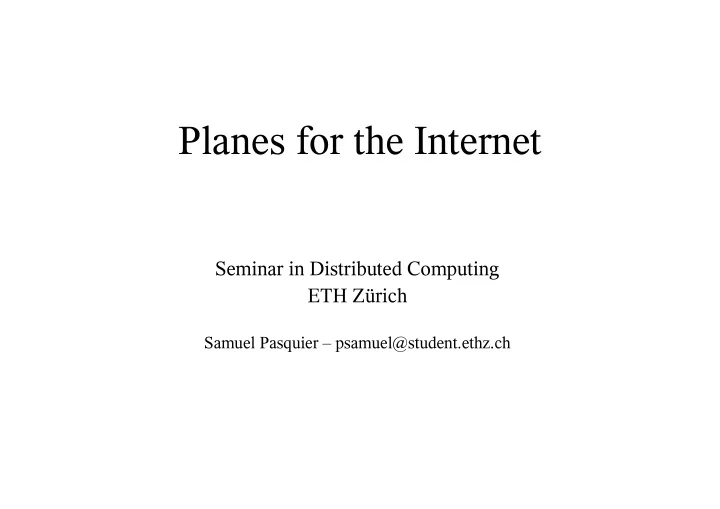

Planes�for�the Internet Seminar in�Distributed�Computing ETH�Zürich Samuel�Pasquier�– psamuel@student.ethz.ch
About�a�Vision…
Motivation • Increasing�reliance on�IP�networks • Increasing�complexity of IP� networks →Increasing�needs for�better techniques�to�manage�them
Overview • Motivation • Existing Planes • A�Clean�Slate Design • Sophia:�An�Information�Plane • The Knowledge Plane • Conclusion
Today’s�Existing Planes • Data�Plane � handles individual packets • Control�Plane � implements the distributed routing algorithm • Management�(Mgmt)�Plane � monitors�the network � configures�Data�Plane�mechanism and Control� Plane�protocols
Existing Planes Difficulties • Today’s�IP�Planes�far�more�complex For�example:� Data Plane’s implementation next-hop forwarding, tunneling, access control, next-hop address translation, queuing forwarding
Existing Planes Difficulties • States�configured by�multiple�entities • Dependencies between the states�and the logic updating the states� (not maintained automatically) • A�change�to�any part�of the configuration�can easily break�other parts� → fragile and complex network
Difficulties Example – Reachability Control Data�Center Front�Office i2.1 R1 R2 i1.1 i1.2 AF�Subnet i2.2 ? R5 BF�Subnet i3.2 i4.2 i3.1 i4.1 R4 R3
Existing Planes Real Example • Just a�made=up case? • 24�hour Blackout of Major�Microsoft�Web� sites� (January 2001) Reason:�improper configuration�of router�by�a� technician • Large�breakdown of Swisscom Backbone network� (3�weeks ago) official�reason:�DDoS Attack hearsay:�improper configuration
Existing Planes Real Example "One�misconfigured router�or�unforeseen� event�can�take�down�a�network.�It�has�to�do� with�architecture,�but�there�are�a�lot�of� unknown�things�that�happen." Keith�Lowry,� vice�president�of�security�operations� for�network�consulting�firm�Pilot�Network�Services
A�Clean�Slate Design
A�Clean�Slate Design Design�Principles • Network=level objectives � Today:�objectives�expressed in�low=level configuration → error=prone!!! � Principle:�Objectives�should be expressed separately from network�elements
A�Clean�Slate Design A�Clean�Slate Design Design�Principles Design�Principles • Network=level objectives � Objectives�concerning performance,�reliability and policy for�example:�Reachability Control� "Do�not allow hosts�in�subnet BF�to�access the accounting servers in�subnet AF" R1 R2 AF�Subnet R5 BF�Subnet R4 R3
A�Clean�Slate Design Design�Principles • Network=level objectives � Purpose:�abstraction� → a�robust network
A�Clean�Slate Design Design�Principles • Network=wide view � Today:�measurement support�added as�an� afterthought � Principle:�coherent snapshot of the state�of each network�component � Time�and space dependant � Information�about�topology,�traffic,�events � Purpose:�a�robust network
A�Clean�Slate Design Design�Principles • Direct�control � Today:�Mgmt Plane�has only indirect�control� over the network � Principle:�only Control�and Mgmt system responsible for�setting all states of the Data� Plane � No�decision logic should be hardwired � Purpose:�meet Network=level objectives
A�Clean�Slate Design Proposal • Propose�4�Planes�to�achieve these objectives • Extreme design�point:�Mgmt and Control�decisions made�in�a�logically centralized fashion
A�Clean�Slate Design Proposal • Decision Plane � makes all the decisions (reachability,�load balancing,…) � needs Network=wide view � uses�standard�algorithms to�turn Network= level objectives into packet=handling state
A�Clean�Slate Design Proposal • Dissemination�Plane � Communication�substrate Data Management�information Plane Decision Plane Discovery states Plane � Dissemination�paths independant from data� path
A�Clean�Slate Design Proposal • Discovery Plane � Discovery of physical components�and their relationships � creates identifiers to�represent them • Data�Plane � handles individual packets (based on�state�given from Decision Plane)
A�Clean�Slate Design Design�Principles reached? • Network=level objectives Decision Plane�satisfies network=level objectives • Network=wide view Decision Plane�operates on�network=wide view • Direct�control Decision Plane�has direct�control�over the operation of the Data�Plane
A�Clean�Slate Design Evaluation� ± Complexity ± Robustness ± Security Solving or�creating problems? Or�moving problems?
Sophia An�Information�Plane
Sophia An�Information�Plane • A�distributed system • incorporates 3�functions ������ ������� � Collecting information�about�network�elements ← � Evaluating statements about�network’s state � Reacting according to�conclusion�drawn ������ ���������
Sophia Building�a�Network=wide view • Goal:�make statements about�the overall network�state�and behavior • uses�Prolog + No�a�priori�assumption about�possible�states�of the system + Programms and data�are�equivalent • Time�and location�explicitly part�of every term
Sophia Network=wide view = Performance • Caching introduced � Tradeoff between most up = to = d ate value�and computation�latency � Ability to�specify evaluation times in�the past • Scheduling � Ability to�specify evaluation time in�the future
Sophia Network=wide view = Performance • Evaluation�planning � Analogy:�Query planning�in�database systems � May�be better to�evaluate some expressions�at some specific locations�and times because�of dependencies � Can�rewrite�original�expression�to�obtain many components�which can benefit from separate planning
Sophia Evaluation + Distributed + Explicit�introduction�of time and space + Appropriate use�of declarative programming language – Incomplete model → ������ ����������� ����� ���������� ������ • Claimed to�be an�incarnation�of the Knowledge Plane�for�PlanetLab…
The Knowledge Plane
The Knowledge Plane Overview Picture�until now
The Knowledge Plane Overview ? Picture�with the Knowledge Plane
The Knowledge Plane Possible�Attributes • In�common with Sophia and the Clean�Slate Design: � Network=wide view � Unified�approach � Sensor=Actuator principle • New: � Explicit�encoutering for�compositional consideration example:�merging perspectives�and activities of two previous unconnected networks
The Knowledge Plane Possible�Attributes • New:� Knowledge produced,�managed and consumed at or�beyond "traditional" edges of the network Sufficient? Source:�Niko Matsakis
The Knowledge Plane Possible�Attributes • ���� � ������������������� = foundation of the Knowledge Plane = operates effectively in�the face�of generality (in�face�of new�technologies,�new�applications) = makes judgement in�presence of partial�or� conflicting informations
The Knowledge Plane Possible�Attributes • ���� � ������������������� = recognizes and mediates conflicts in�policies and goals = performs optimizations,�too complicated for� humans,�in�high=dimensional environments
The Knowledge Plane Why a�Cognitive�System? • Traditional�algorithmic approaches to�adaptivity are�unlikely to�provide the required level of sophistication � Because�they require: = complete information�(in�general) = precise problem formulations = relatively static environment
The Knowledge Plane Characteristics • The Cognitive�Systems (CS)�should be able�to�… � … learn and reason: = CS�improves when new�situations�are�recognized,�new� actions�performed:� the knowledge base�grows in�useful ways � … gain�experience and trust: = CS�is ultimately able�to�recognize problems and to�act on�its own
The Knowledge Plane An�Architecture? • Speculative ;=) • Relevant�points: � Distributed � Constraint driven (system may adopt any behavior which is not specifically constrained) � Bottom=up (composition/decomposition of simple� entities to/from complex entities)
The Knowledge Plane Evaluation �� ? • A�way to�handle the complexity of networks�(?) • Representing knowledge is already difficult • Reasoning about�it even more�difficult • Would need cognitive�performance� outperforming human capabilities Looking at actual state�of AI… ���� ��������
Recommend
More recommend